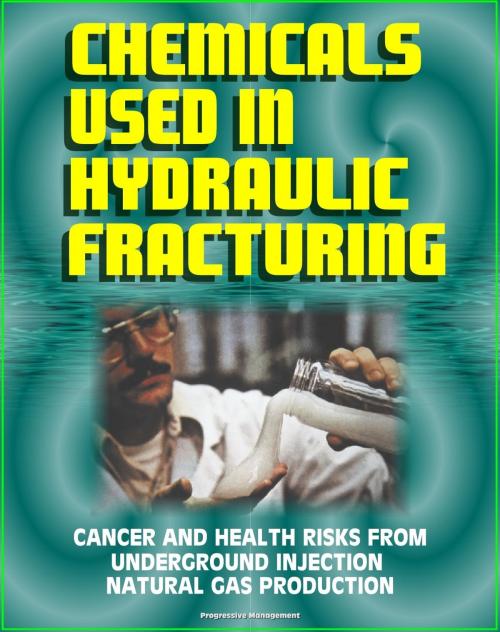Chemicals Used in Hydraulic Fracturing: Cancer and Health Risks from Underground Injection Natural Gas Production, Marcellus Shale Gas Fracking and Hydrofrac - House Committee Report
Nonfiction, Science & Nature, Science, Earth Sciences, Geology, Biological Sciences, Ecology| Author: | Progressive Management | ISBN: | 9781458151216 |
| Publisher: | Progressive Management | Publication: | April 26, 2011 |
| Imprint: | Smashwords Edition | Language: | English |
| Author: | Progressive Management |
| ISBN: | 9781458151216 |
| Publisher: | Progressive Management |
| Publication: | April 26, 2011 |
| Imprint: | Smashwords Edition |
| Language: | English |
Investigators with the House Committee on Energy and Commerce have discovered that oil and gas service companies conducting hydraulic fracturing for shale gas production used more than 2500 fracturing products containing 750 chemicals, some of which are toxic and carcinogenic. This report lists every chemical disclosed by the industry, and reveals that some of the chemicals remain proprietary and cannot be identified.
According to the report:
Hydraulic fracturing has helped to expand natural gas production in the United States, unlocking large natural gas supplies in shale and other unconventional formations across the country. As a result of hydraulic fracturing and advances in horizontal drilling technology, natural gas production in 2010 reached the highest level in decades. According to new estimates by the Energy Information Administration (EIA), the United States possesses natural gas resources sufficient to supply the United States for approximately 110 years. As the use of hydraulic fracturing has grown, so have concerns about its environmental and public health impacts. One concern is that hydraulic fracturing fluids used to fracture rock formations contain numerous chemicals that could harm human health and the environment, especially if they enter drinking water supplies. The opposition of many oil and gas companies to public disclosure of the chemicals they use has compounded this concern.
Last Congress, the Committee on Energy and Commerce launched an investigation to examine the practice of hydraulic fracturing in the United States. As part of that inquiry, the Committee asked the 14 leading oil and gas service companies to disclose the types and volumes of the hydraulic fracturing products they used in their fluids between 2005 and 2009 and the chemical contents of those products. This report summarizes the information provided to the Committee.
Between 2005 and 2009, the 14 oil and gas service companies used more than 2,500 hydraulic fracturing products containing 750 chemicals and other components. Overall, these companies used 780 million gallons of hydraulic fracturing products – not including water added at the well site – between 2005 and 2009. Some of the components used in the hydraulic fracturing products were common and generally harmless, such as salt and citric acid. Some were unexpected, such as instant coffee and walnut hulls. And some were extremely toxic, such as benzene and lead. Appendix A (included in this reproduction) lists each of the 750 chemicals and other components used in hydraulic fracturing products between 2005 and 2009.
This is a privately authored news service and educational publication of Progressive Management. Our publications synthesize official government information with original material - they are not produced by the federal government. They are designed to provide a convenient user-friendly reference work to uniformly present authoritative knowledge that can be rapidly read, reviewed or searched. Vast archives of important data that might otherwise remain inaccessible are available for instant review no matter where you are. This e-book format makes a great reference work and educational tool. There is no other reference book that is as convenient, comprehensive, thoroughly researched, and portable - everything you need to know, from renowned experts you trust. For over a quarter of a century, our news, educational, technical, scientific, and medical publications have made unique and valuable references accessible to all people. Our e-books put knowledge at your fingertips, and an expert in your pocket!
Investigators with the House Committee on Energy and Commerce have discovered that oil and gas service companies conducting hydraulic fracturing for shale gas production used more than 2500 fracturing products containing 750 chemicals, some of which are toxic and carcinogenic. This report lists every chemical disclosed by the industry, and reveals that some of the chemicals remain proprietary and cannot be identified.
According to the report:
Hydraulic fracturing has helped to expand natural gas production in the United States, unlocking large natural gas supplies in shale and other unconventional formations across the country. As a result of hydraulic fracturing and advances in horizontal drilling technology, natural gas production in 2010 reached the highest level in decades. According to new estimates by the Energy Information Administration (EIA), the United States possesses natural gas resources sufficient to supply the United States for approximately 110 years. As the use of hydraulic fracturing has grown, so have concerns about its environmental and public health impacts. One concern is that hydraulic fracturing fluids used to fracture rock formations contain numerous chemicals that could harm human health and the environment, especially if they enter drinking water supplies. The opposition of many oil and gas companies to public disclosure of the chemicals they use has compounded this concern.
Last Congress, the Committee on Energy and Commerce launched an investigation to examine the practice of hydraulic fracturing in the United States. As part of that inquiry, the Committee asked the 14 leading oil and gas service companies to disclose the types and volumes of the hydraulic fracturing products they used in their fluids between 2005 and 2009 and the chemical contents of those products. This report summarizes the information provided to the Committee.
Between 2005 and 2009, the 14 oil and gas service companies used more than 2,500 hydraulic fracturing products containing 750 chemicals and other components. Overall, these companies used 780 million gallons of hydraulic fracturing products – not including water added at the well site – between 2005 and 2009. Some of the components used in the hydraulic fracturing products were common and generally harmless, such as salt and citric acid. Some were unexpected, such as instant coffee and walnut hulls. And some were extremely toxic, such as benzene and lead. Appendix A (included in this reproduction) lists each of the 750 chemicals and other components used in hydraulic fracturing products between 2005 and 2009.
This is a privately authored news service and educational publication of Progressive Management. Our publications synthesize official government information with original material - they are not produced by the federal government. They are designed to provide a convenient user-friendly reference work to uniformly present authoritative knowledge that can be rapidly read, reviewed or searched. Vast archives of important data that might otherwise remain inaccessible are available for instant review no matter where you are. This e-book format makes a great reference work and educational tool. There is no other reference book that is as convenient, comprehensive, thoroughly researched, and portable - everything you need to know, from renowned experts you trust. For over a quarter of a century, our news, educational, technical, scientific, and medical publications have made unique and valuable references accessible to all people. Our e-books put knowledge at your fingertips, and an expert in your pocket!















